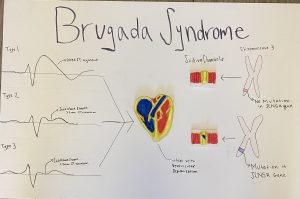For the art portion of my project, I did a visual representation of Brugada Syndrome. On the left side of the poster, I drew the 3 different ECGs that could potentially indicate Brugada Syndrome. In the middle of the poster, I have a clay model of the heart. The challenging part about representing Brugada Syndrome is that most of those impacted have a structurally normal heart. With that being said, those affected with Brugada Syndrome, who are symptomatic, have issues with the ST segment which indicates an issue with ventricular depolarization. Since ventricular depolarization is initiated at the apex of the heart, I have indicated that part on the clay model. Although there are multiple causes of Brugada Syndrome, the most common is a genetic mutation in the SCN5A gene on Chromosome 3. This mutation reduces the function of the sodium channels in the cardiac muscle as indicated by the clay sodium channel on the poster. The lack of sodium in the heart causes heart arrhythmia and issues with ventricular depolarization.

Lainey does a wonderful job of explaining the complex actions that are happening regarding Brugada Syndrome. Brugada Syndrome causes people who suffer from it to have a irregular heart beat, specifically in the ST segment of the heartbeat. Lainey explains in her project that several different arrhythmia’s could indicate there is a presence of Brugada Syndrome. She explains the most common cause of Brugada Syndrome is a mutation of the SCN5A gene which causes the heart to improperly engage in the depolarization of the heart. The clay models are a perfect replication of the heart as well as the variation in the genetic mutation of the SCN5A displayed by the cut segments in the chromosomes. The painting helps indicate the differences in the left ventrical, right ventrical, left atrium, and right atrium. The painting also helps make clear distinction between the outer walls and veins and the hollow spaces of the atriums and ventricles. Along the side she does a wonderful job of drawing out the differences in the types arrhythmia’s that could be signs of Brugada Syndrome. She displays the difference in the sodium channels which is the leading issue of people with Brugada Syndrome. The sodium blockage in the channels doesn’t allow for the proper ratio into the heart to keep the rhythm of the heart stable for homeostasis of the body. If the heart doesn’t beat out the correct rhythm than issues like low blood pressure and even bad circulation at the least and much worse health concerns if Brugada Syndrome isn’t managed.